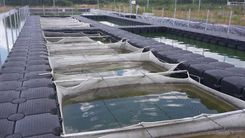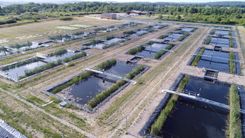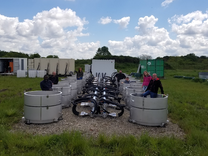Facilities
Transnational Access
Metadata & Data
Papers & Reports
Knowledge Base
National Experimental Platform in Aquatic Ecology (PLANAQUA)
CNRS CEREEP
Infrastructure Description
PLANAQUA is a cutting-edge experimental infrastructure located at the CEREEP Research Centre to explore the effects of human disturbances on aquatic biodiversity, community structure and ecosystem functioning of shallow lakes ecosystems. PLANAQUA is jointly supported by Ecole Normale Supérieure (ENS) and National Centre of Scientific Research (CNRS). PLANAQUA combines several facilities. Sixteen artificial ponds (750 m3), with a vegetated, silty, littoral zone, a central pelagic zone, and a sandy benthic area, are equipped with automated sensors to measure vertical profiles of t°C, O2, pH, chl a and PAR. Two larger ponds (4000 m3) serve as storage (for species and water) or drainage reservoirs. In the first pond, a floating pontoon can receive suspended enclosures (typically, 64 enclosures of 6 m3). The experimental ponds are complemented by >80 outdoor mesocosms of various sizes (1-15 m3) and shapes. Finally, 12 mesocosms (15 m3 each) have wave generators to control water turbulence.
Aquatic communities (plankton, benthos, macrophytes of marine or freshwater ecosystems) can also be studied in the climatic chambers of the Ecotron IleDeFrance, under highly controlled environmental conditions (t°C, light, nutrients, gas). Dedicated sensors enable monitoring of gas exchange (O2 and CO2) in the experimental systems. Microcosms (from one liter to several hundreds of liters) can be used.
Available instruments include a flow cytometer, spectrophotometer, automatic titrator, segmented flow analyser, growth cabinets, a laminar flow hood, fume hoods, -20°C and -80°C freezers, an autoclave, ovens, a freeze-drier, culture facilities for algae, microscopes, liquid nitrogen, distilled and ultrapure water, samplers, fixed sensors, multi-parameter and fluorometric probes, small boats and other gear.

Facility Description
outdoor/indoor- pelagic/littoral – freshwater/marine
1) The Experimental Lake Platform consists of 16 artificial lakes (30 m x 15 m x 3 m deep, 750 m3 each) designed to simulate the spatial heterogeneity and biological complexity of small, continental freshwater bodies (Figure 1). These large experimental systems are spatially structured, with shallow littoral areas, a central pelagic zone and a central benthic area, and may be interconnected along 4 rows of 4 lakes each through 10 m long dispersal channels. In addition, each lake is equipped since June 2016 with automated sensors and data loggers providing detailed and real time information on physical and biological conditions along the water column from the central pelagic zone. The two other artificial reservoirs (126 m x 15 m x 3 m deep, 4000 m3) are a stocking lake used to homogenise water before distribution to experimental lakes and a drainage lake that can collect and purify used water at the end of experiments.
2) Standard outdoor freshwater mesocosms, from 350 litres to 12 m3, with high degree of replication are available (currently, 142 tanks with a minimum of 12 replicates per size group).
3) Standard floating mesocosms (up to 2.5 m deep and 5.6 m3) can be installed on a permanent floating structure of the stocking lake to run mesocosm experiments requesting a deeper and naturally mixed water column (Figure 3).
4) The new platform of thermoregulated mesocosms inaugurated in June 2021 is now available for TA 2022. 16 stainless steel mesocosms of 1m3 are set outdoor in two lines of 8 mesocosms (Figure 4). Four experimental temperatures can be precisely controlled, each one on four replicated mesocosms. This allows factorial experiments aiming to understand the effects of global warming and other environmental parameters on community structure and functioning.
5) Aquatic microcosms are small containers dedicated to aquatic microbial ecosystems studies from single populations to communities of bacteria, microalgae and other planktonic organisms. Currently, we have in our dedicated laboratories 12 chemostats (single glass vessels) for culturing bacteria and phytoplankton in sterile conditions and 4 double-system chemostats (paired system made out of two connected glass vessels) dedicated to the study of phyto- and zooplankton interactions and dynamics in spatially structured ecosystems (meta-ecosystems) (Figure 5). All the systems can be used to run continuous cultures in a light- and temperature-controlled environment. Moreover, we have 36 custom-made open-top aquatic microcosms dedicated to experimentation on aquatic ecosystems in the Ecolab environmental chambers. Temperature, irradiance and nutrients can be precisely controlled inside each microcosm, and atmospheric conditions (CO2 and O2) are precisely regulated.
Organisation Address
CEREEP-Ecotron IleDeFrance
11 chemin de Busseau
Saint Pierre lès Nemours
77140
France
Infrastructure Address
70 km southeast of Paris
Saint-Pierre-lès-Nemours
France
Information Sources
Location
Gallery
Contacts
Sarah Fiorini
Gérard Lacroix
Controlled Parameters
fish presence and abundance, nutrients, waves and water mixing, temperature, irradiance, gas concentrations.
Research Topics
Effects of human disturbances on aquatic biodiversity, community structure and ecosystem functioning. Long-term study of the bottom-up and top-down control of the functioning of complex communities with heterogeneous spatial distributions, consequences of anthropogenic pressures on biodiversity, up to the species at the top of the food web. Studies of the link between physical constraints and the functioning of aquatic systems. Studies on ecophysiology and activity of microbial aquatic communities.
Experiment Years
Since 2009
TA Support
Services currently offered by the infrastructure: The PLANAQUA platform is open to researchers and private companies around the world. Users have access to laboratories, office space, instruments, dormitories (12 double rooms and a dormitory) and lodging facilities at the CEREEP. Up to 30 guests can be hosted. Visiting scientists are generally encouraged to cooperate with the CEREEP technical team responsible for running the infrastructure and with scientists of the associated laboratories.
Support offered under AQUACOSM: CEREEP has procedures in place to provide support to all external users. They will have access to the range of available laboratories, office space and instruments. Users will benefit from support provided by permanent staff to assist with technical advice and purchase of consumables, and the adaptation and further development of equipment and instruments. CEREEP academic staff is qualified to participate to all aspects of a proposed experiment (conception, implementation, field sampling, instrument use, data interpretation, etc.). based on agreements made before the beginning of an experiment. All external users will receive support in terms of planning of activities before and after arrival as well as hands-on training by the local scientific and technical staff.
Support offered under AQUACOSM-plus: Users will benefit from support provided by permanent staff to assist with technical advice, purchase of consumables, and the adaptation and further development of equipment and instruments. CEREEP academic staff is prepared to participate to all aspects of a proposed experiment (conception, implementation, field sampling, instrument use, data interpretation, etc.). Based on agreements made before the beginning of an experiment. All external users will receive support in terms of planning of activities before and after arrival as well as hands-on training by the local scientific and technical staff.
TA Modality of Access
Modality of access under AQUACOSM: least 450 person-days in total will be allocated to external users through AQUACOSM Transnational Access provision in years 2-4. Users will be encouraged to apply for AQUACOSM support particularly to cooperate in an ongoing long-term experiment (>4 years) to assess the importance of bottom-up and top-down control of complex communities in a spatially structured habitat. To that end, half of the 16 lakes have been progressively fertilised since 2015, and fish communities will be added in a full factorial design in the autumn of 2016. Users interested in participating in this experiment are most welcome. However, efforts will be made to accommodate also independent experiments that could either be integrated into the ongoing project.
Mesocosms offered by PLANAQUA are freely available for guest researchers to develop their own projects.
Access is offered to at least 5 persons for 30 days each year.
Modality of access under AQUACOSM-plus: At least 320 person-days in total will be allocated to external users through AQUACOSM Transnational Access provision. It is anticipated that AQUACOSM-plus will support stays of at least 7 persons for 43 days for one year within M10-45. Users will be encouraged to apply for AQUACOSM support particularly to cooperate in an ongoing long-term experiment (>4 years) to assess the importance of bottom-up and top-down control of complex communities in a spatially structured habitat. To that end, half of the 16 ponds have been progressively fertilised since 2015, and fish communities will be added in a full factorial design in the autumn of 2016.
TA Accommodation
CEREEP – Ecotron Ile de France is able to host up to 36 sleeping guests (12 double rooms and a dormitory for students). In addition, through cooperation with the laboratories associated in the PLANAQUA project, the infrastructure may favour collaboration with other laboratories in Ile-de-France and access to other facilities.
TA Rules
PLANAQUA is a member of the national infrastructure AnaEE France dedicated to experimentation on ecosystems. All submitted projects must be registered in the data base of projects of this national infrastructure and users will have to agree with our user charter and publication policy. Details available at http://isia-cereep.anaee-france.fr/ and on request.



